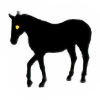HOME | DD
 AngelFire1 — Horse Coloring Tutorial
AngelFire1 — Horse Coloring Tutorial

Published: 2008-08-29 16:44:38 +0000 UTC; Views: 26620; Favourites: 215; Downloads: 452
Redirect to original
Description
*****Please Download*****Photoshop Elements Tutorial for Realistically Coloring an Equine.
For this tutorial I am using WSTopDeck’s lineart, found here: [link]
I am also assuming you know the basics of PS Elements, if you don’t; this tutorial is not for you.
Step One: Using the magic wand tool, select and delete all of the white sections on the lineart layer, leaving transparency. It sometimes helps to put a dark color on a layer under the lines, so you can see exactly where you have little white spots. Then, use the burn tool to darken your lines until they are clear and black. Remove the layer underneath, and name the layer with the lines on it, Lineart. Once you have clean lines, move on to step two. (Not Pictured)
Step Two: Once you have your lineart, make a new layer, move it under your lines, and name it Color Swatches (Or something to that effect). Choose your basic shades, the ones that you will build off of. I chose to make a nice palomino this time, so my colors are goldish red and bluish silver. Never use pure white or black, even if you choose a too-saturated color it can always be fixed.
After you have your base colors, choose three to six colors darker than the base, and three to six colors lighter than the base. I like to make my base color spots bigger than the others so I know they are the base. I find that I don’t make all of my color swatches at the start; often I start with the basic ones and build as I make the horse. Once you have your colors, move on the step three.
Step Three: Create a new layer under your lineart, but over your color swatches and label it Body Base. Take your base body shade and fill in the horse, don’t worry about neatness. Once you have the body filled in, take the magic wand tool, move onto your lineart layer, and select everything but the body of the horse. This means you select the background, mane, tail, and hooves. Then move back onto the body base layer and hit the delete key on your keyboard. All of the color that is not in the lines is now gone. Once you have your base color on your body, move to step four.
Step Four: Create a new layer on top of your body base, and label it ‘Shading.’ Take the next darkest shade from your color swatches, and follow the curves of the body. I love WSTopDeck’s lineart because she has many small muscle lines that are very helpful. For instance, in the face, shade along the nose, the mouth, and the muscle lines, and so on. Make sure that with the first few shades you use a soft brush, so that when you move to a smaller brush and darker color, they don’t just overlap. Once you have your first shade on, hide the lineart layer by clicking the little picture of an eye. Then take your smudge tool, set it at about 10% for the head and 25-30% for the rest of the body. Gently smudge it, but make sure that you are smudging in the direction of the hair. Make sure the edges are blended well.
Step Five: Repeat step four with the darker shades, using a smaller brush every time, and being sure to smudge a little less each time, until you have it shaded in such a way that when you hide the lineart, the shadows and such are visible and defined. Here is my finished shading:
Step Six: Create another layer on top of your shading layer and name it highlights. Then take the first shade lighter than your base and loosely blotch in the main highlights. Use a small brush on the legs and face. Once you have the first highlights on, hide the lineart layer and smudge the highlights with the same settings as in step four. Make sure you smudge in the direction of the hair and that the edges are blended well.
Step Seven: Repeat step six with the lighter colors, using a really small brush and being careful not to highlight too much. Here are my finished highlights.
Step 8: After I do the horse itself, I like to do the markings, eye, and hooves. I’m going to start with the hooves. Since my horse has light legs, his hooves will be a light tan and bluish silver. Take a base shade (See I added to my color chart?) and make a new layer. Call it ‘Details’. Fill in the hooves, not worrying about neatness. Horse hooves have a kind of horizontal banding that I like to show in my pictures. I use a self-made speckle brush to add the details. It’s easy to make your own, just make a bunch of dots with the pen tool, then select the area, and go to edit: define brush, name it and it’ll be in your brushes. Take a darker shade and a lighter shade and lightly sweep the speckle brush over the hooves.
Once you’ve finished, you can smudge a tad if you’d like. Otherwise, use the magic wand on the lineart layer to select everything but the hooves, then go back to this layer and delete the stuff that’s not in the lines.
Next comes the eye. My character has turquoise colored eyes, so my base will be a medium shade of it. After you have this shade, choose a much darker, almost black shade. Then turn on the lineart layer, make a new layer under it, and use the lighter shade to color in the iris. Take a darker shade of this and make little spots in the eye for detail. Then use the dark shade to outline the eye and pupil. Finally, on a new layer, make a white spot on the eye. Seeing as my horse has no markings, we will now move on to the mane and tail.
Step 9: To begin the mane and tail, make a new layer. Fill in the shapes with your base color, and then use the magic wand on the lineart layer to select everything but the mane and tail. Then go delete all the excess color. Then make a new layer and taking the speckly brush you made earlier, begin to add detail in the shadows. Continue making the shadows and such, then go and make highlights. Finally, I like to add some sparkles using the leaf brush on the dodge tool at a low exposure.
Step 10: After finishing step nine, I decided that my mane and tail were too saturated with blue, so I used the hue/saturation adjustor to desaturate it a bit, and then I lightened it a tad.
Tada!
However, I made some booboos that I need to fix, so I use the clone tool to fix it.
Step 11: Now, delete the color swatches layer, and merge all of the layers down, but don’t merge the lineart layer. Select the logo and copy it, than paste it into the finished picture. Delete your lineart layer and tada!
If you have any questions please let me know!!
AF1
**********************************************
Resources & Tutorials that may be helpful:
Lineart:
~stableblondy
=silverglass19
=IceKrystal
*WSTopDeck
Horse Tutorials:
[link]
[link]
[link]
[link]
[link]
Related content
Comments: 19

im going to be using this today because i want to make a really nice one!
this will really help
👍: 0 ⏩: 0

O.O This looks insainly familiar, did you perchance frequent the forum Howrse'design? (use to have a light colored layout with pinks and peach colors and clouds?) I was Silver_Moonlight there
👍: 0 ⏩: 0

Gimp could also work fairly well for this, and you can do some pretty awesome pixel work in MS paint with some patience.
👍: 0 ⏩: 0

I'm just starting to work with Photoshop^^ Seems like I understand how this whole 'layer-thing' works now 
👍: 0 ⏩: 1

Of course! Dont forget that there are a TON of tutorials out there for everything you could possibly want to make/do, and thats how I learned everything.
👍: 0 ⏩: 1

The problem is that I often don't have the nerves to try this all^^ I rather want to find out how it works myself. I'll keep it in mind better, then.
👍: 0 ⏩: 0

I want to try this why Paint.net (a.k.a. the cheap person's photoshop 
👍: 0 ⏩: 1

Of course! I'm glad you like it!
👍: 0 ⏩: 0

wow O_O *hugs you massivly* you dont know how much this has helped ^^ I've only just started using photoshop, and layering using equestrians and I've been really stuck but this tutorial has really helped me ^^, thanks to you I can really improve now
👍: 0 ⏩: 1

Of course!
Sadly I cant even use it anymore, since my programs wont work on this computer -frusterated glare- but otherwise, I'm glad I could help!
👍: 0 ⏩: 0

thats so cool do you think it will work with gimp?
👍: 0 ⏩: 1

As long as you have the same tools, yes, it should.
👍: 0 ⏩: 1

ok good because it looks like it works well
👍: 0 ⏩: 0























